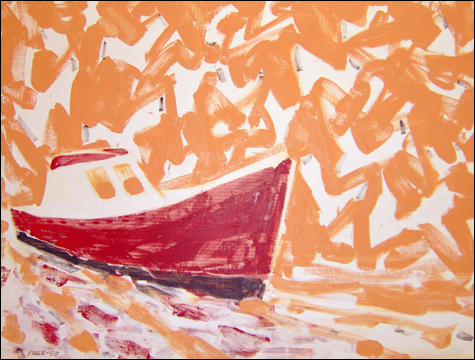
SARDINE BOAT, TANGERINE SKY: By Stephen Pace, oil on canvas, 1990.
|
|
Stephen Pace | through Dec 30 | at Elizabeth Moss Gallery, 251 US Rte 1, Falmouth | 207.784.2620
|
The show of paintings by Stephen Pace at the Elizabeth Moss Gallery in Falmouth allows us to witness a small section of the arc of a career that has spanned several decades of what were arguably the most interesting times in American art. Now in his late 80s, Pace came of age artistically in New York in the circle of artists that included Franz Kline, Mark Rothko, Adolph Gottlieb, Barnett Newman, and his particular friend Milton Avery.
Pace lived and worked in New York and, starting in the ’50s, the coast of Maine. He has summered in Stonington since the early ’70s. Now, to be near family, he and his wife are moving to the University of Southern Indiana in Evansville, where a new museum will have a gallery devoted to his work. The university is providing him with a studio. There also will be a collection of his work at Fryeburg Academy, but he won’t be coming to Maine to paint any more. It feels like an era in Maine art is slipping away.
This may well be the last show of Stephen Pace paintings in a Maine commercial gallery. It consists of a dozen or so paintings, mostly oil on canvas, the earliest of which is from 1954, and the latest from 2006.
Throughout his career Pace has crossed back and forth between pure, non-objective abstraction and representation; the two modes informed one another. Abstraction taught him that color, stroke and shape can carry expressive weight without reference to an image. The Maine landscape provided him with ideas, color, light, and pictorial organization that gave him poetic range.
A good example is Sardine Boat, Tangerine Sky, an oil on canvas from 1990. It’s a deceptively simple work that shows a typical Maine red work boat from about three-quarters head-on, surrounded by orange sky and sea. The sky is a series of orange strokes of paint punctuated by occasional dark marks. The sea is also orange, with some red to indicate the boat’s reflection.
Maine work boats are the subject of thousands of paintings, most of which have little or nothing to say. In this painting Pace reports on the essential quality of the light over the sea on that particular day, rather than just mimicking that which could be done with a snapshot. By seeing orange where most would say "gray" or "blue" and presenting the color with coherence, he refers to the complexity and depth of what really happens visually in that environment.
In Quarry Reflections, from 1977, Pace crosses and re-crosses the abstraction/representation boundary. It’s an arresting painting, standing out from its neighbors. Blue shapes suggesting trees get smaller as they ascend from gray shapes (stones) across the middle of the picture, while similar blue shapes get smaller as they descend, below, the lower shapes being the "reflections." They are all surrounded by a field of lighter blue strokes, suggesting the sky and its reflection, while choppy green strokes suggest trees or foliage.
The representational reading of this painting is the least interesting way to see it; a postcard of the same scene would carry more documentary information. By using the light, color, and organization of the scene as his starting point, Pace is able to convey something that is more truth than fact. What we are witnessing is an alert consciousness conveying something meaningful about the subjective experience of that place on that day, reminding us that all experience is subjective, and that all truly worthwhile art conveys something personal and important from one person to another.
The generation of artists like Pace and Milton Avery, William Keinbusch, and William Thon, who understood the abstract nature of art and who cared about the experience of nature are passing from the scene and from art-world fashion, and it’s a great pity. Something fundamental to the artistic enterprise is going with them.
Email the author
Ken Greenleaf:
ken.greenleaf@gmail.com